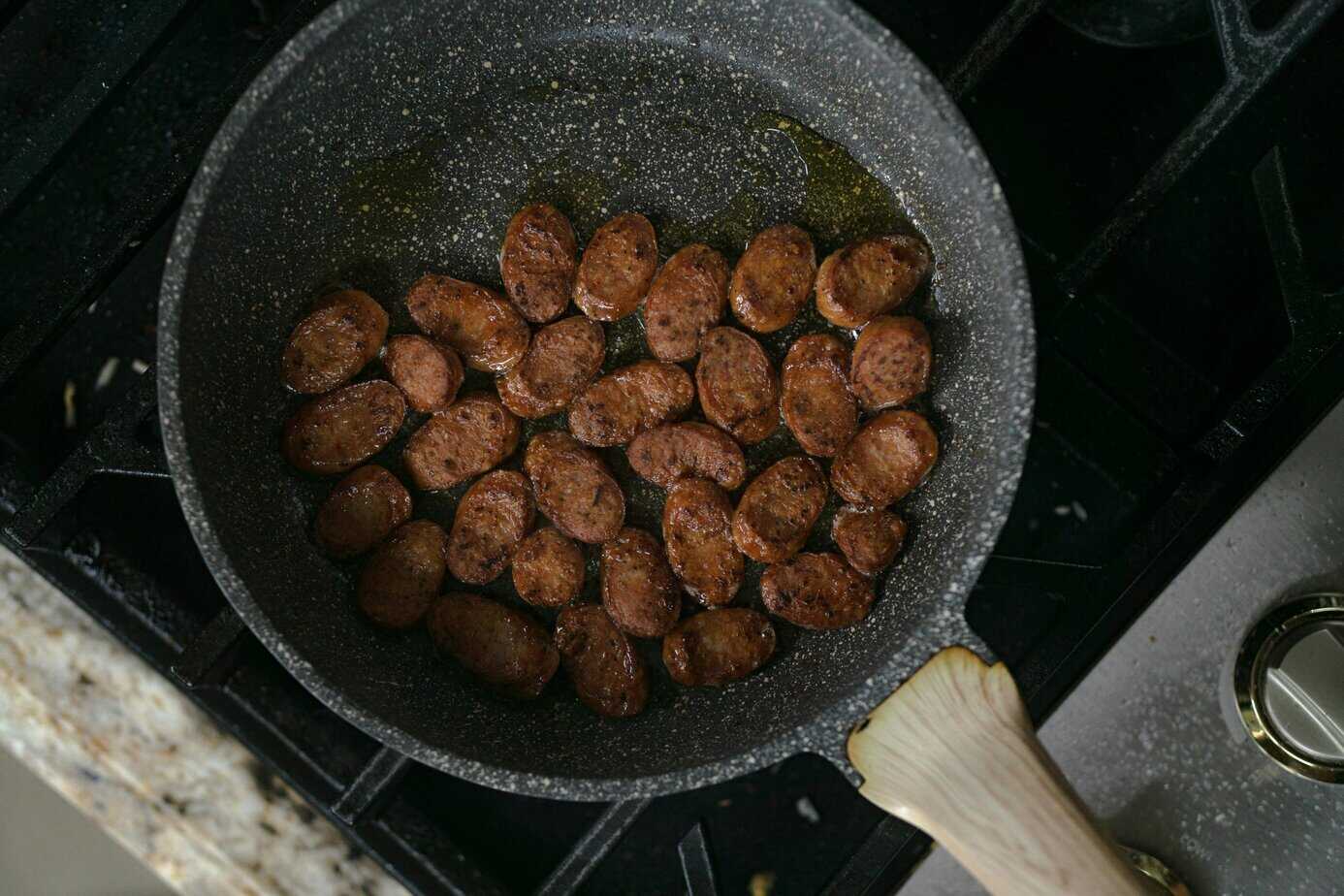Al fresco chicken sausage is one of those weeknight saviors, simple to heat, easy to pair, and done in under fifteen minutes. You just need a skillet, a little oil, and a plan for what to serve alongside. Whether you want crisp sausage slices or plump, juicy links, stovetop cooking lets you get dinner on the table fast without sacrificing flavor.
Key Takeaways
- Use medium to medium-high heat for the best browning and juicy sausage.
- Brown whole links or slices in a skillet with olive oil, turning often for even color.
- Add vegetables to the pan for a full one-pan meal, and store leftovers safely for busy days.
Preparing Al Fresco Chicken Sausage for Cooking
Selecting and Preparing the Sausage
Choosing the Right Flavor and Type
Al Fresco chicken sausage comes in different flavors. Here are some popular choices:
- Sweet Italian: A mild flavor, perfect for kids.
- Roasted Pepper: Adds a nice savory touch.
- Asiago: Creamy and cheesy, great for special meals.
- Spicy Italian: A kick for grown-ups who like heat.
- Smoked: Offers a deeper flavor, perfect for grilling.
You can also compare it to some of the world’s best chicken sausage options to find what fits your taste.
Removing Packaging and Slicing Options
- Peel Away the Plastic: Take off the casing or plastic wrap around the sausage.
- Decide on Preparation:
- Whole Links: Good for dishes like sausage-and-peppers or sandwiches.
- Sliced Medallions: Cut the sausage into ½-inch slices. This gives you more browned edges, which are best for dishes like pasta, rice, or quick stir-fries.
Preparing Accompaniments
Selecting Vegetables for Sautéing
Choose vegetables that pair well with chicken sausage. Here are some great options:
- Bell Peppers: Sweet and colorful.
- Onions: Savory and sweet when cooked.
- Tomatoes: Juicy and fresh, they add moisture.
- Zucchini: Light and mild, cooks quickly.
Slice the vegetables thin so they cook fast. You can also add a handful of spinach or cherry tomatoes at the end for extra flavor.
Seasoning and Additional Flavorings
Keep seasoning simple. Here are some ideas:
- Salt and Pepper: Basic but essential.
- Italian Herbs: A sprinkle can add nice flavor.
- Fresh Garlic: Minced garlic adds depth.
- Black Pepper: A grind enhances taste.
You can also have a squeeze of lemon or a splash of balsamic vinegar ready for a finishing touch.
Stove Top Cooking Techniques
Preheating and Preparing the Pan

Source: Dining Playbook
Preheating is key: Heating the pan (empty) over medium heat for about a minute, or until a flicked water droplet sizzles and evaporates, ensures even heat distribution, better browning, and reduced sticking (1)
- Choose a Skillet: Use a large skillet for cooking. This gives you plenty of space for the sausage and vegetables.
- Set the Heat: Place the skillet over medium to medium-high heat. This will warm it up nicely without burning your food.
- Add Oil: Pour in a swirl of olive oil. You only need enough to coat the bottom lightly. If you prefer, you can use nonstick cooking spray instead.
This preparation ensures that your sausage cooks evenly and doesn’t stick to the pan. Keeping the heat at medium will help achieve a nice brown color without overcooking.Once your pan is ready, you can move on to cooking the sausage and any accompanying vegetables. Enjoy the process!
Optimal Heat Level (Medium to Medium-High)
Finding the right heat level is important for cooking sausage. Here’s what to keep in mind:
- Too Hot: Skillet surface temperatures exceeding 400 °F (≈204 °C) can cause the sausage exterior to char before the interior reaches a safe temperature, risking an undercooked center (2).
- Too Low: If the heat is too low, you won’t get that nice browning. The sausage may cook slowly and lose flavor.
- Just Right: Medium to medium-high heat is ideal. This temperature gives a golden sear without drying out the sausage.
By keeping the heat in this range, you can achieve a crispy exterior while ensuring the inside is warm and juicy. Adjust as needed while cooking to maintain that perfect balance. Enjoy the delicious results!
Using Olive Oil or Nonstick Cooking Spray
When it comes to cooking sausage, you have a couple of good options for adding fat to the pan:
- Olive Oil: This is a classic choice. It adds flavor to the sausage and helps it brown nicely. It’s great for most dishes and gives a tasty finish.
- Nonstick Cooking Spray: This is a good option if you’re using low-fat sausage or cooking in a nonstick pan. It keeps things from sticking without adding extra calories.
A Few Things to Avoid:
- Butter: Don’t use butter for high-heat cooking. It burns quickly, which can ruin the taste of your dish. Instead, stick with olive oil or cooking spray for better results.
By choosing the right fat, you can ensure your sausage cooks well and tastes great. Enjoy your cooking!
Cooking the Sausage Properly

Cooking Whole Links: Timing and Turning
- Lay the Links in the Skillet: Place the sausage links in the hot skillet. Make sure not to crowd them. Each link needs some space to cook evenly.
- Initial Cooking Time: Let the links sit in the skillet for about two minutes. This helps them start browning.
- Start Turning: After two minutes, begin turning the links every minute or so. This ensures they cook evenly on all sides.
- Browning Time: Overall, it should take about 7 to 10 minutes for the links to brown nicely.
Check for Doneness: You want the sausage to be hot all the way through. The outside should have a crisp, golden skin,especially important when working with Italian chicken sausage links like these.
Cooking Sliced Sausage: Browning and Even Cooking
- Spread Out the Medallions: Place the sausage slices in a single layer in the skillet. This helps them cook evenly and get a nice color.
- Let Them Brown: Don’t stir constantly. Let the slices sit for about two to three minutes. This allows the bottoms to turn golden brown.
- Flip the Slices: After two to three minutes, flip the medallions over. This will brown the other side.
- Repeat Cooking Time: Continue cooking for another two to three minutes on this side.
- Total Cooking Time: The slices should heat through in about 6 to 8 minutes total.
Following these steps will ensure your sausage medallions are browned nicely and cooked evenly. Enjoy your flavorful dish!
Incorporating Vegetables
Timing for Adding Vegetables
Add firmer vegetables (onions, peppers, carrots) right after the sausage starts browning. Softer ones (spinach, tomatoes) can go in near the end. Move sausage to the pan’s edge or remove briefly if you need space.
Achieving Tenderness and Flavor Integration
Let veggies pick up the sausage’s flavor. When they soften and the sausage is browned, everything’s ready. Deglaze the pan with a splash of chicken broth or white wine if bits start sticking.
Ensuring Proper Doneness and Safety
Understanding Al Fresco Sausage Pre-Cooking
Most al fresco chicken sausage is fully cooked, so you’re not worried about raw centers,just heating through and browning.
Heating vs. Cooking Raw Sausage
If you ever start with raw chicken sausage (not typical for al fresco), check that the internal temperature reaches 165°F. With pre-cooked sausage, just make sure it’s steaming hot.
Checking Internal Temperature and Visual Cues
You should see juices bubble and the sausage plump up as it heats. If you have a thermometer, check for 165°F in the center. Mostly, you’ll know by the sizzle and color.
Signs of Proper Browning and Heating
Good sausage is golden with a few darker spots. Slices have browned faces, links feel springy. If it looks pale or sweats a lot, turn up the heat a notch.
Serving, Storage, and Enhancements
Serving Suggestions and Pairings
Serve the sausage right from the skillet. If you prefer, let it rest for a minute before slicing for sandwiches. Here are some tasty ways to enjoy it:
- With Sautéed Vegetables: Pair it with colorful veggies for a healthy meal.
- On a Bed of Rice: This makes for a filling dish.
- Tossed with Pasta: Mix it into your favorite pasta for added flavor.
- Inside a Crusty Roll: Perfect for a hearty sandwich.
You can even try the best chicken sausage varieties for different textures and flavors in these meals.Try adding grainy mustard or a sprinkle of fresh herbs for extra flavor.
Presentation Tips for Best Appeal
Make your dish look as good as it tastes. Here are some tips:
- Add Color: Scatter chopped parsley or basil over the top for a fresh look.
- Arrange Thoughtfully: Place sausage slices or links next to bright vegetables for a vibrant plate.
Storing Leftovers Safely
To keep leftovers fresh, follow these steps:
- Cool Quickly: Let the sausage cool down fast.
- Store Properly: Place it in an airtight container in the fridge.
- Use Within Four Days: Leftovers are good for up to four days.
Reheating Methods for Best Texture
When reheating sausage, keep these tips in mind:
- Use a Skillet: Reheat in a skillet over low heat.
- Add Moisture: A splash of water or broth helps keep it juicy.
- Microwaving: This works, but it can toughen the casing, so use it as a last resort.
Flavor Boosting Tips
Want to enhance the flavor? Try these ideas:
- Add Aromatics: Sauté garlic, onions, or a pinch of chili flakes for depth.
- Don’t Crowd the Pan: Space out your ingredients for better browning and flavor.
- Finish Strong: Add a squeeze of lemon, a dash of vinegar, or some grated cheese for a delicious finish.
Conclusion
Cooking Al Fresco chicken sausage on the stovetop is one of those kitchen wins,quick, tasty, and super flexible. Whether you’re browning up whole links for sandwiches or slicing them into golden coins for pasta or stir-fries, a hot skillet and a little oil are all you really need. Just keep the heat at medium to medium-high, don’t overcrowd the pan, and let those sausages get nice and brown. Throw in some veggies while you’re at it, and you’ve got a one-pan dinner that’s ready in under 15 minutes. Leftovers? No problem,just store them right and reheat with care. And if you want to take the flavor up a notch, a splash of lemon or a sprinkle of herbs goes a long way. It’s simple, it’s fast, and it makes weeknights way easier. So grab that skillet and make dinner something to look forward to.
FAQ
Can I use cooking spray instead of oil when cooking chicken sausage in a skillet?
Cooking sausage with cooking spray is a great low-fat method, especially for chicken sausage. Just heat a skillet over medium-high, spray lightly, and cook. Avoid butter,it burns easily and alters flavor. This keeps your dish light and flavorful
What’s the right internal temperature for chicken sausage when reheating or cooking?
Chicken sausage should reach 165°F internally. Even if it’s pre-cooked, ensure it’s heated through,use a thermometer if unsure. This is key for safe chicken sausage meal prep.
Can I freeze chicken sausage and how should I thaw it before cooking?
Freezing chicken sausage is fine,just wrap it well and label. Thaw in the fridge overnight for the best texture and flavor. Avoid thawing on the counter.
What are some good herbs or garnishes for finishing a skillet chicken sausage meal?
Garnish chicken sausage with parsley or basil to boost flavor, especially in one-pan meals. Basil pairs well with garlic sausage; parsley suits Italian herb sausage.
References
- https://www.foodandwine.com/should-i-preheat-my-skillet-
- https://www.webstaurantstore.com/blog/3514/what-is-the-maillard-reaction.html
Related Articles
- https://milkwoodrestaurant.com/worlds-best-chicken-sausage/
- https://milkwoodrestaurant.com/how-to-cook-italian-chicken-sausage-links/
- https://milkwoodrestaurant.com/what-chicken-sausage-is-the-best/
Was this helpful?

I’m Mary R. Q. , a seasoned professional chef dedicated to elevating home cooking experiences. Through my expertise in the culinary arts, I provide practical cooking tips and insightful reviews of kitchen utensils on my blog, milkwoodrestaurant.com. As a passionate advocate for transforming everyday meals into extraordinary culinary adventures, I aim to empower home cooks with the knowledge and tools they need to create delicious and memorable dishes. I’m also an author of the book “1,001 Kitchen Tips & Tricks: Helpful Hints for Cooking, Baking, and Cleaning (1,001 Tips & Tricks)” which is sold on Amazon. Join me on a flavorful journey as we explore the art of cooking and the essential tools that make it a joy.








